Abstract
The structural requirements for the inhibition of ferrochelatase by N-alkylated porphyrins were investigated and experiments carried out to explore the mechanism of enzyme inhibition. Three dicarboxylic porphyrins, all substrates of the enzyme, are strongly inhibitory when N-alkylated; in contrast, uroporphyrin and coproporphyrin (which are not substrates) do not inhibit after N-alkylation. Free carboxylic acid functions are required for inhibition, as the methyl ester derivatives are not themselves inhibitory. Porphyrins bearing the alkyl group on the pyrrole nitrogen of rings C and D are less effective inhibitors, particularly when zinc is chelated in the centre of the tetrapyrrole or the N-alkyl group is relatively large in size. The substituents at the 2- and 4-positions of the porphyrin system may also affect the inhibitory activity, particularly for the isomers with ring C and D alkylated. The zinc chelates of several N-alkylprotoporphyrins are inhibitory towards haem oxygenase, another haem-binding enzyme, and also in this case increasing the size of the alkyl group decreased the inhibitory activity, particularly for isomers with ring C or D alkylated. The inhibition could be reversed by prolonged incubation with excess porphyrin substrate, but dealkylation of the N-alkylporphyrin during enzyme inhibition could not be demonstrated. It is concluded (a) that N-alkylated dicarboxylic porphyrins compete reversibly with the porphyrin substrate for the enzyme active site and (b) that the structural and steric factors discussed above affect the inhibitory activity by modifying the affinity of the N-alkylporphyrin inhibitor for the enzyme.
Full text
PDF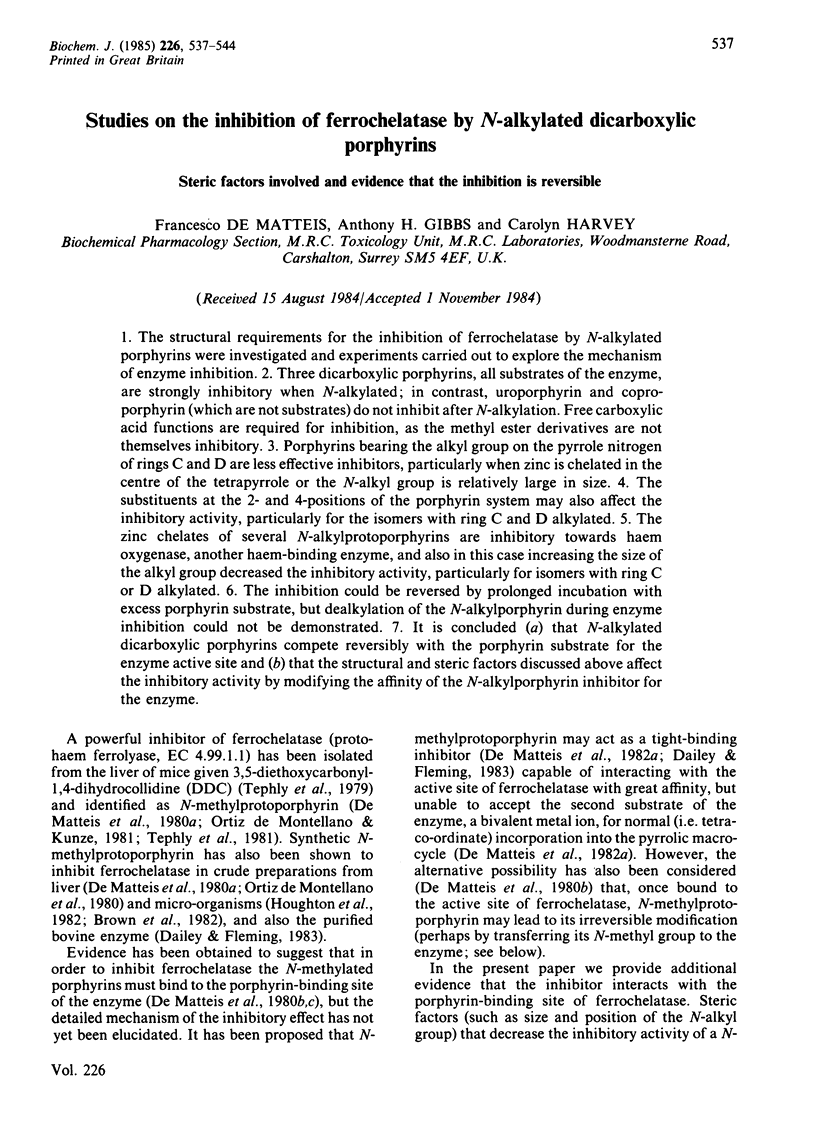
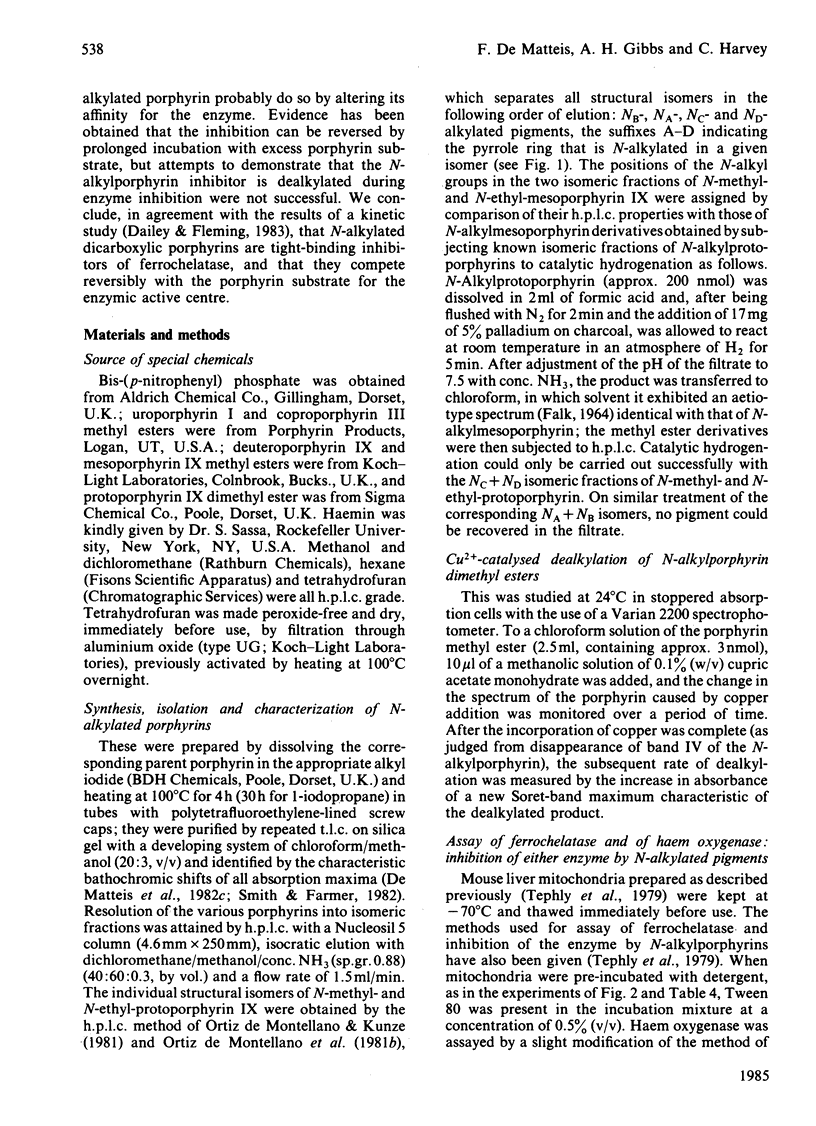

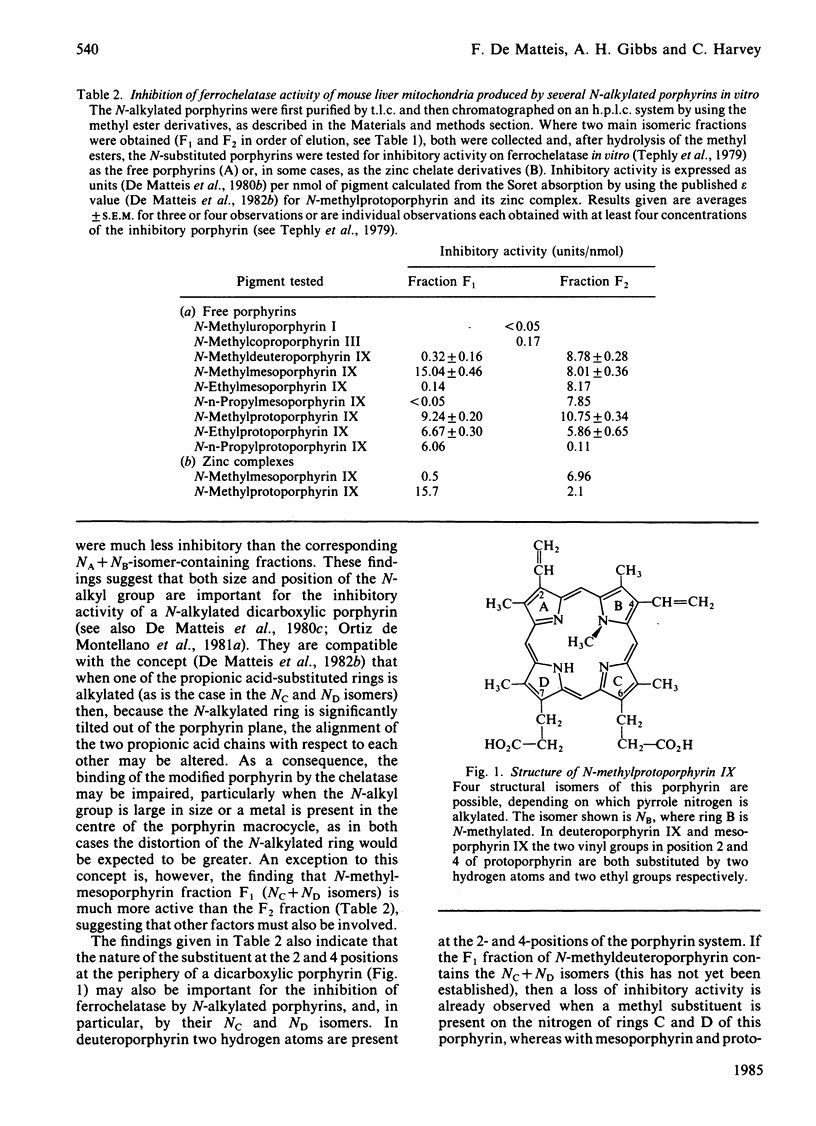
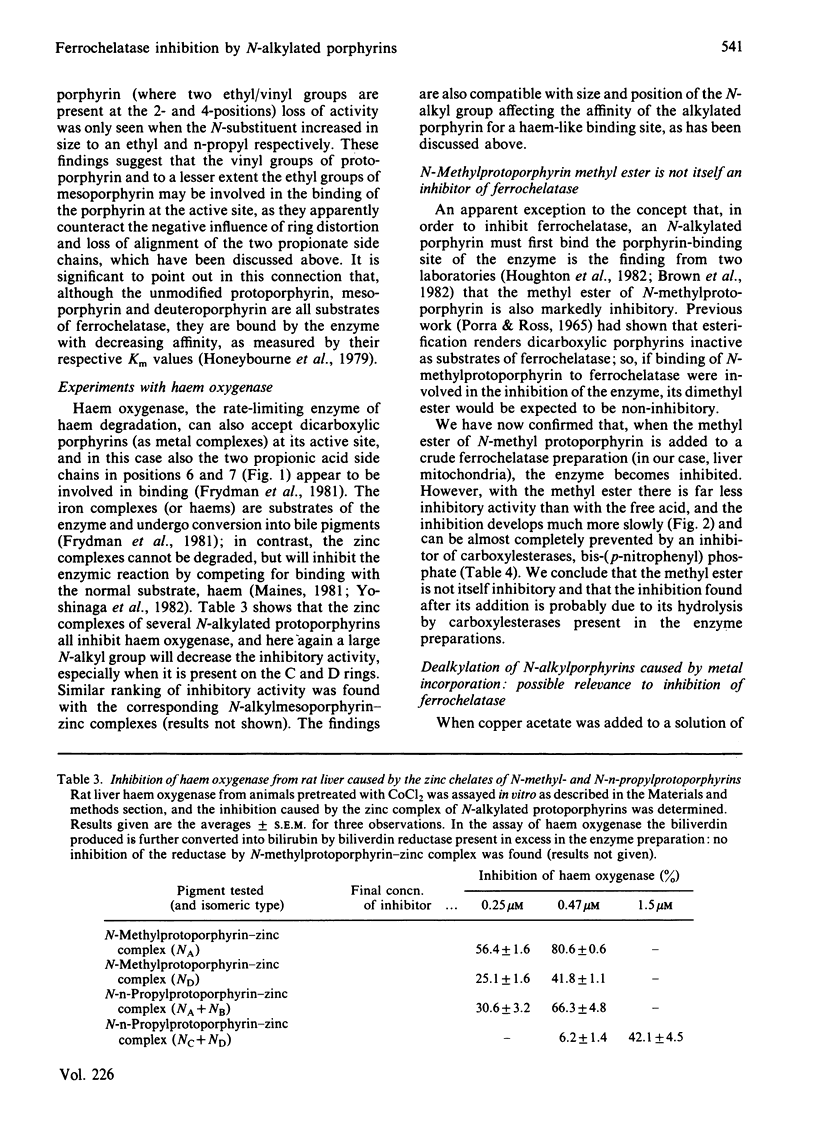
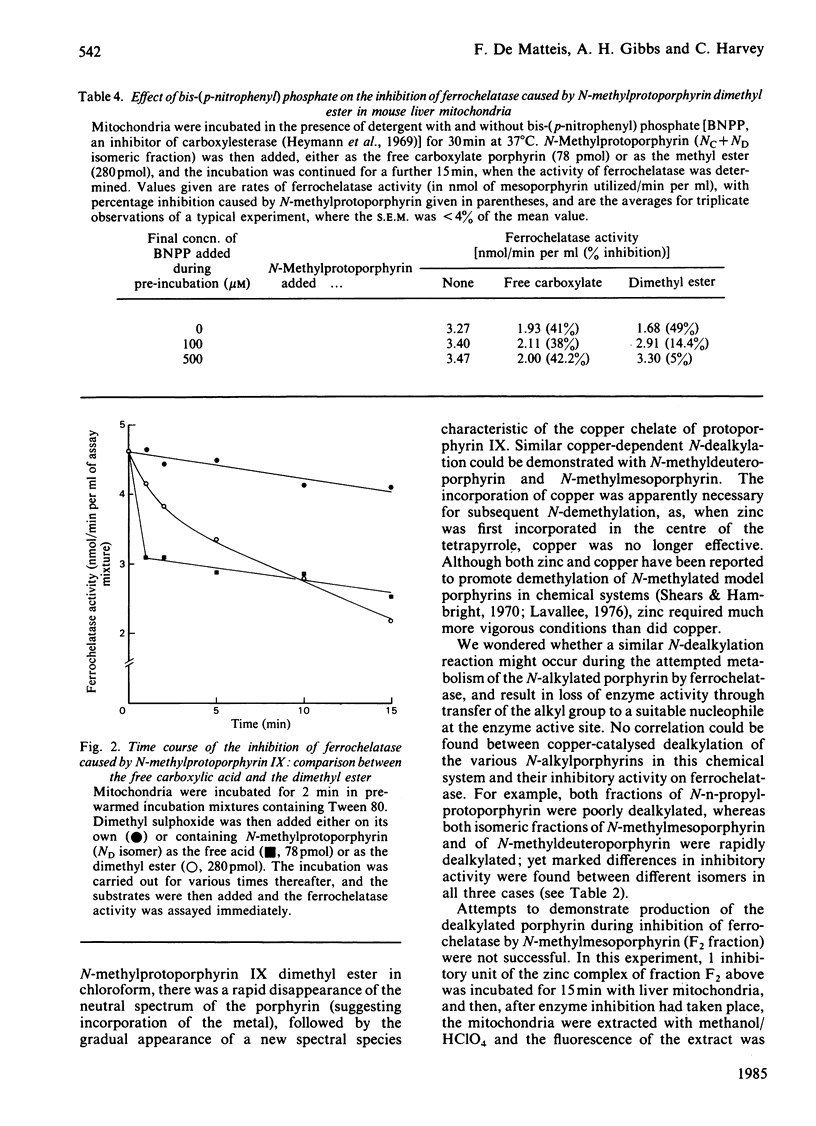
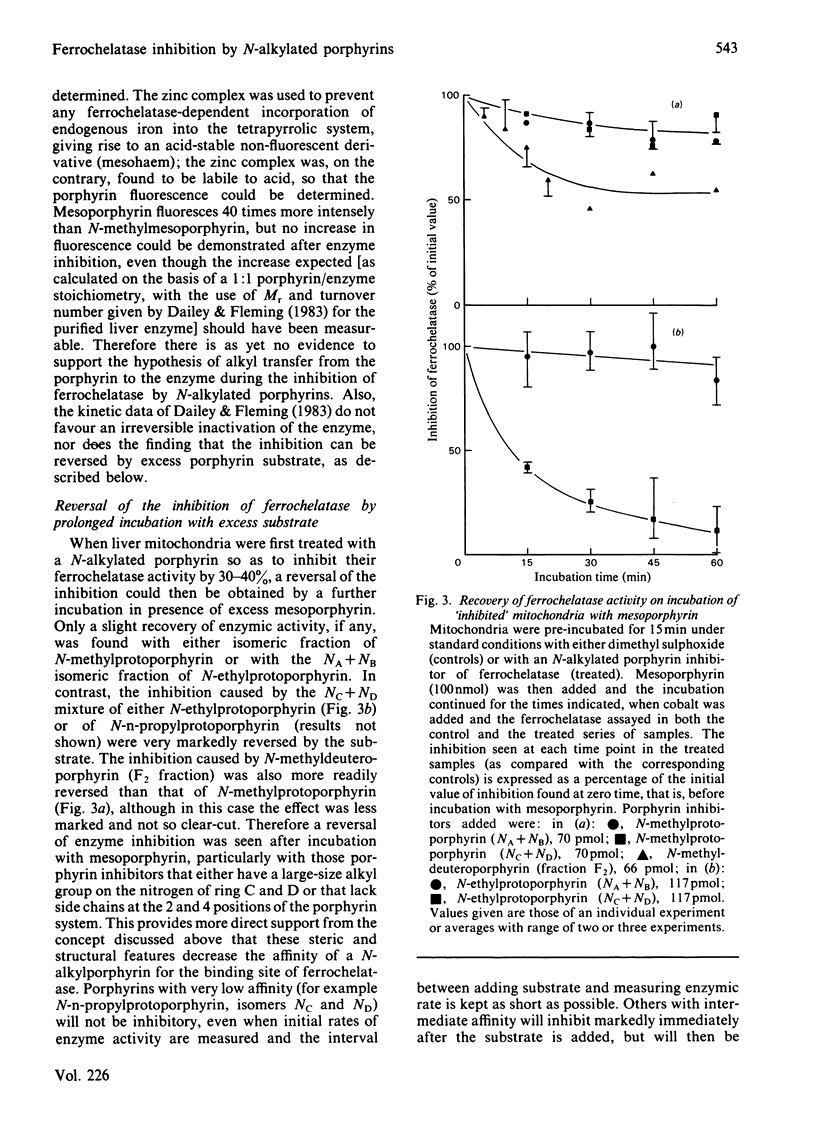
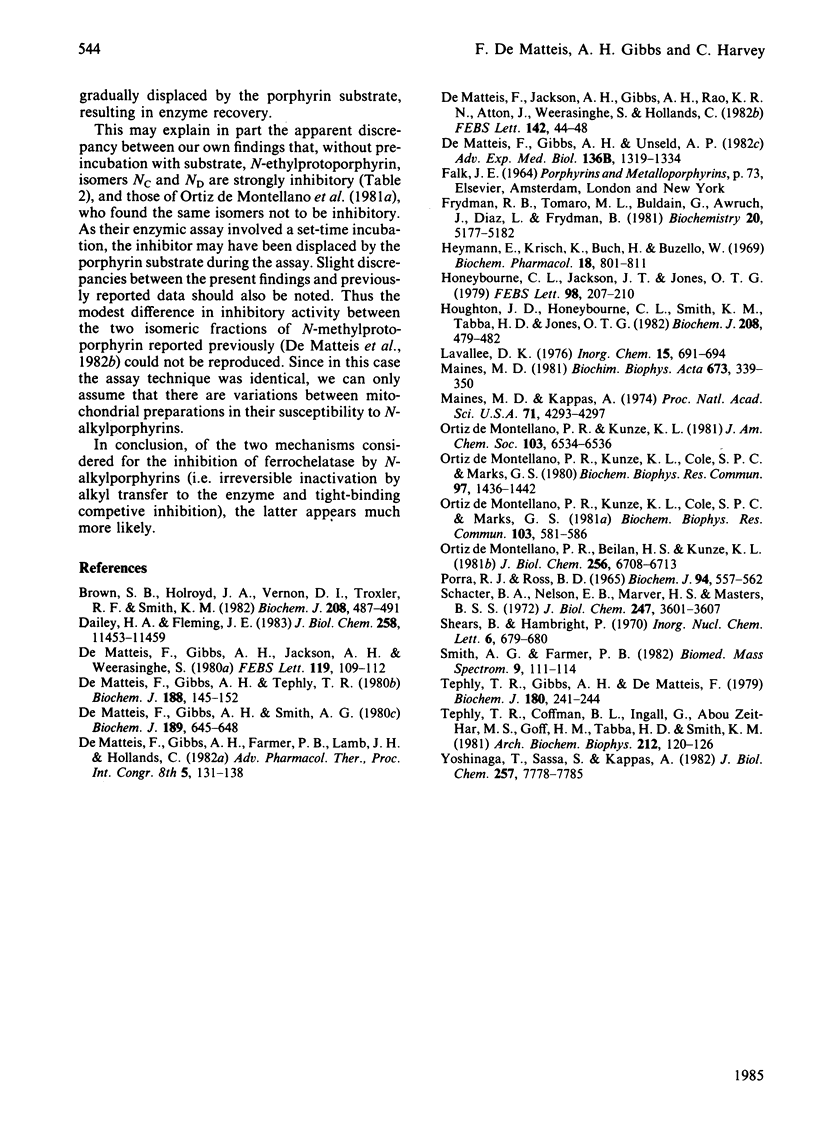
Selected References
These references are in PubMed. This may not be the complete list of references from this article.
- Brown S. B., Holroyd J. A., Vernon D. I., Troxler R. F., Smith K. M. The effect of N-methylprotoporphyrin IX on the synthesis of photosynthetic pigments in Cyanidium caldarium. Further evidence for the role of haem in the biosynthesis of plant billins. Biochem J. 1982 Nov 15;208(2):487–491. doi: 10.1042/bj2080487. [DOI] [PMC free article] [PubMed] [Google Scholar]
- Büch H., Buzello W., Heymann E., Krisch K. Inhibition of phenacetin- and acetanilide-induced methemoglobinemia in the rat by the carboxylesterase inhibitor bis-[p-nitrophenyl] phosphate. Biochem Pharmacol. 1969 Apr;18(4):801–811. doi: 10.1016/0006-2952(69)90050-1. [DOI] [PubMed] [Google Scholar]
- Dailey H. A., Fleming J. E. Bovine ferrochelatase. Kinetic analysis of inhibition by N-methylprotoporphyrin, manganese, and heme. J Biol Chem. 1983 Oct 10;258(19):11453–11459. [PubMed] [Google Scholar]
- De Matteis F., Gibbs A. H., Smith A. G. Inhibition of protohaem ferro-lyase by N-substituted porphyrins. Structural requirements for the inhibitory effect. Biochem J. 1980 Sep 1;189(3):645–648. doi: 10.1042/bj1890645. [DOI] [PMC free article] [PubMed] [Google Scholar]
- De Matteis F., Gibbs A. H., Tephly T. R. Inhibition of protohaem ferro-lyase in experimental porphyria. Isolation and partial characterization of a modified porphyrin inhibitor. Biochem J. 1980 Apr 15;188(1):145–152. doi: 10.1042/bj1880145. [DOI] [PMC free article] [PubMed] [Google Scholar]
- De Matteis F., Jackson A. H., Gibbs A. H., Rao K. R., Atton J., Weerasinghe S., Hollands C. Structural isomerism and chirality of N-monosubstituted protoporphyrins. FEBS Lett. 1982 Jun 1;142(1):44–48. doi: 10.1016/0014-5793(82)80216-0. [DOI] [PubMed] [Google Scholar]
- Frydman R. B., Tomaro M. L., Buldain G., Awruch J., Díaz L., Frydman B. Specificity of heme oxygenase: a study with synthetic hemins. Biochemistry. 1981 Sep 1;20(18):5177–5182. doi: 10.1021/bi00521a012. [DOI] [PubMed] [Google Scholar]
- Honeybourne C. L., Jackson J. T., Jones O. T. The interaction of mitochondrial ferrochelatase with a range of porphyrin substrates. FEBS Lett. 1979 Feb 1;98(1):207–210. doi: 10.1016/0014-5793(79)80185-4. [DOI] [PubMed] [Google Scholar]
- Houghton J. D., Honeybourne C. L., Smith K. M., Tabba H. D., Jones O. T. The use of N-methylprotoporphyrin dimethyl ester to inhibit ferrochelatase in Rhodopseudomonas sphaeroides and its effect in promoting biosynthesis of magnesium tetrapyrroles. Biochem J. 1982 Nov 15;208(2):479–486. doi: 10.1042/bj2080479. [DOI] [PMC free article] [PubMed] [Google Scholar]
- Maines M. D., Kappas A. Cobalt induction of hepatic heme oxygenase; with evidence that cytochrome P-450 is not essential for this enzyme activity. Proc Natl Acad Sci U S A. 1974 Nov;71(11):4293–4297. doi: 10.1073/pnas.71.11.4293. [DOI] [PMC free article] [PubMed] [Google Scholar]
- Maines M. D. Zinc . protoporphyrin is a selective inhibitor of heme oxygenase activity in the neonatal rat. Biochim Biophys Acta. 1981 Mar 18;673(3):339–350. doi: 10.1016/0304-4165(81)90465-7. [DOI] [PubMed] [Google Scholar]
- Ortiz de Montellano P. R., Beilan H. S., Kunze K. L. N-Alkylprotoporphyrin IX formation in 3,5-dicarbethoxy-1,4-dihydrocollidine-treated rats. Transfer of the alkyl group from the substrate to the porphyrin. J Biol Chem. 1981 Jul 10;256(13):6708–6713. [PubMed] [Google Scholar]
- Ortiz de Montellano P. R., Kunze K. L., Cole S. P., Marks G. S. Differential inhibition of hepatic ferrochelatase by the isomers of N-ethylprotoporphyrin IX. Biochem Biophys Res Commun. 1981 Nov 30;103(2):581–586. doi: 10.1016/0006-291x(81)90491-5. [DOI] [PubMed] [Google Scholar]
- Ortiz de Montellano P. R., Kunze K. L., Cole S. P., Marks G. S. Inhibition of hepatic ferrochelatase by the four isomers of N-methylprotoporphyrin IX. Biochem Biophys Res Commun. 1980 Dec 31;97(4):1436–1442. doi: 10.1016/s0006-291x(80)80026-x. [DOI] [PubMed] [Google Scholar]
- PORRA R. J., ROSS B. D. HAEM SYNTHASE AND COBALT PORPHYRIN SYNTHASE IN VARIOUS MICRO-ORGANISMS. Biochem J. 1965 Mar;94:557–562. doi: 10.1042/bj0940557. [DOI] [PMC free article] [PubMed] [Google Scholar]
- Schacter B. A., Nelson E. B., Marver H. S., Masters B. S. Immunochemical evidence for an association of heme oxygenase with the microsomal electron transport system. J Biol Chem. 1972 Jun 10;247(11):3601–3607. [PubMed] [Google Scholar]
- Tephly T. R., Coffman B. L., Ingall G., Ziet-Har M. S., Goff H. M., Tabba H. D., Smith K. M. Identification of N-methylprotoporphyrin IX in livers of untreated mice and mice treated with 3, 5-diethoxycarbonyl- 1, 4-dihydrocollidine: source of the methyl group. Arch Biochem Biophys. 1981 Nov;212(1):120–126. doi: 10.1016/0003-9861(81)90350-7. [DOI] [PubMed] [Google Scholar]
- Tephly T. R., Gibbs A. H., De Matteis F. Studies on the mechanism of experimental porphyria produced by 3,5-diethoxycarbonyl-1,4-dihydrocollidine. Role of a porphyrin-like inhibitor of protohaem ferro-lyase. Biochem J. 1979 Apr 15;180(1):241–244. doi: 10.1042/bj1800241. [DOI] [PMC free article] [PubMed] [Google Scholar]
- Yoshinaga T., Sassa S., Kappas A. Purification and properties of bovine spleen heme oxygenase. Amino acid composition and sites of action of inhibitors of heme oxidation. J Biol Chem. 1982 Jul 10;257(13):7778–7785. [PubMed] [Google Scholar]
- de Matteis F., Gibbs A. H., Jackson A. H., Weerasinghe S. Conversion of liver haem into N-substituted porphyrins or green pigments. Nature of the substituent at the pyrrole nitrogen atom. FEBS Lett. 1980 Sep 22;119(1):109–112. doi: 10.1016/0014-5793(80)81009-x. [DOI] [PubMed] [Google Scholar]


